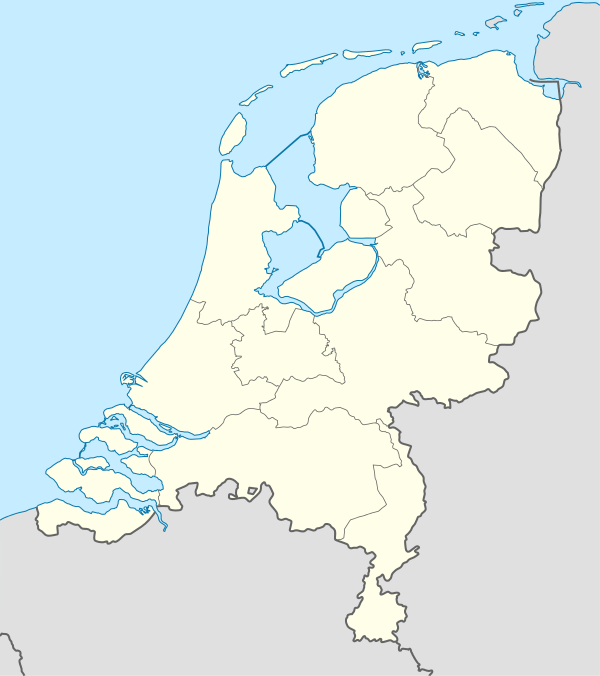Lange Jaap
 Lange Jaap | |
 | |
| Location |
Huisduinen Netherlands |
|---|---|
| Coordinates | 52°57′19.74″N 4°43′35.06″E / 52.9554833°N 4.7264056°ECoordinates: 52°57′19.74″N 4°43′35.06″E / 52.9554833°N 4.7264056°E |
| Year first constructed | 1822 (first) |
| Year first lit | 1878 (current) |
| Construction | cast iron tower |
| Tower shape | 16-sided tapered prism with gallery, lantern and rotating antenna |
| Markings / pattern | red tower and dome, white lantern |
| Height | 55.5 metres (182 ft)[1] |
| Focal height | 57 metres (187 ft) |
| Original lens | 1st order Fresnel lens |
| Intensity | 5,200,000 cd |
| Range | 30 nautical miles (56 km; 35 mi) |
| Characteristic | Fl (4) W 20s. |
| Admiralty number | B0858 |
| NGA number | 114-9884 |
| ARLHS number | NET-051 |
| Netherlands number | NL-1494[2] |
Lange Jaap ("Long James"), also known as Kijkduin Light or Den Helder Light, is an active lighthouse near fort Kijkduin in Huisduinen, Netherlands. At a height of 182 feet (55 m) it is one of the tallest "traditional lighthouse" in the world.[3] For almost a century, from 1878 to 1974, it was the tallest lighthouse in the Netherlands, until the construction of Maasvlakte Light.
According to The Lighthouse Directory it is the tallest non-skeletal cast iron lighthouse in the world. That may be the case if the height is as specified in that source (63.5 metres (208 ft)). However, if the height is 55.5 metres (182 ft). As stated by other sources it is the second tallest, Cikoneng Light being 190 feet (58 m).[4][5]
The site is open and accessible. However, due to safety concerns the tower has been closed to the public since 1998.
History

The first aid to navigation at the site was a simple coal fire lit from 1814, at Fort Kijkduin, a few hundred meters south of the current tower. In 1822 the construction of the first tower was completed and it was first lit on 29 October 1822. The tower was a 22 metres (72 ft) tall, six floor brick tower. The light consisted of 26 Argand lamps with parabolic reflectors, visible up to 6 nautical miles (11 km; 6.9 mi). Cracks in the building foundation were repaired twice, in 1826 and 1827. In 1853 the light was replaced by an Argand lamp lens system with fixed Fresnel lens. The shell of the former lantern is displayed outdoors in the royal dockyard of Willemsoord in Den Helder.
The construction of the second and current lighthouse started on 1877 and first lighting was on 1 April 1878. The first lens system was a stationary lens with Argand lamps from the old tower. In 1903 this was replaced with a Barbier and F.B. rotational system, with Mercury bearings. It used incandescent kerosene and had an intensity of 1,200,000 cd. Its characteristic was 2 flashes every 10s and was visible for "20 English miles".
In 1912 an improved pharoline incandescent light was installed. In 1924 the light was electrified in 1924 and a Brandaris 80V 50A lamp was fitted.
In 1940, during World War II, this light system was destroyed. An emergency light was installed in 1945, with an intensity of 62,000 cd. On September 2, 1949 the current 920mm 1st order Fresnel lens was installed, with the current characteristic.
In 1988 the site was listed as a Rijksmonument.
In 1998 the lighthouse was closed to the public due to cracks on the cast iron floors. Although it was refurbished in 1999 and a new coat of paint was applied, as of 2002 it is unlikely that the tower will be reopened, especially due to harder safety regulation since the Volendam café disaster and the formation of the Dutch Safety Board.[6]
Construction
The 17 floor 284 step tower was designed by Quirinus Harder and prefabricated by Penn & Bauduin in Dordrecht. It was constructed from 1,088 iron plate and 21,446 nuts and bolts.
See also
- List of tallest lighthouses in the world
- List of lighthouses in the Netherlands
- List of Rijksmonuments
References
- ↑ According to List of Lights and Vuurtoren in Nederland. The Lighthouse Directory has 63.5 metres (208 ft).
- ↑ Rowlett, Russ. "Lighthouses of Northern Netherlands". The Lighthouse Directory. University of North Carolina at Chapel Hill. Retrieved February 21, 2016.
- ↑ Rowlett, Russ. "The Tallest Lighthouses". The Lighthouse Directory. University of North Carolina at Chapel Hill.
- ↑ List of Lights, Pub. 112, Western Pacific and Indian Oceans Including the Persian Gulf and Red Sea (PDF). List of Lights. United States National Geospatial-Intelligence Agency. 2009. p. 358.
- ↑ Rowlett, Russ. "Lighthouses of Indonesia: Java". The Lighthouse Directory. University of North Carolina at Chapel Hill.
- ↑ "Openstelling Helderse vuurtoren onwaarschijnlijk" [Opening Helder Lighthouse unlikely]. vuurtorens.net (in Dutch). 29 September 2002. Retrieved 11 August 2010.
- Rowlett, Russ. "Lighthouses of Northern Netherlands". The Lighthouse Directory. University of North Carolina at Chapel Hill.
- List of Lights, Pub. 114, British Isles, English Channel and North Sea (PDF). List of Lights. United States National Geospatial-Intelligence Agency. 2010. p. 154.
- "Vuurtoren in Nederland - Vuurtoren Den Helder" [Lighthouses in the Netherlands - Den Helder Lighthouse]. vuurtorens.net (in Dutch). Retrieved 11 August 2010.
- "Vuurtorens in Nederland - Vuurtoren Fort Kijkduin (Afgebroken):" [Lighthouses in the Netherlands - Kijkduin for Lighthouse (Aborted)]. vuurtorens.net (in Dutch). Retrieved 11 August 2010.
| Wikimedia Commons has media related to Lange Jaap Lighthouse. |